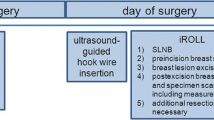Abstract
Background
Leakiness of angiogenic tumor vessels results in elevated pressure in primary breast cancers and increased lymphatic flow to sentinel lymph node(s) (SLNs). We hypothesized that a similar pathophysiology in metastatic axillary SLNs would result in increased intranodal pressure (INP).
Methods
SLNs were “hot” and “blue” after intramammary injection of dilute methylene blue and filtered Tc99 sulfur colloid. Intraoperative pressure was measured in SLNs by a noncoring needle and recording device in 114 breast cancer patients. Excised axillary SLNs were examined by standard pathological techniques and metastases measured, recorded, and compared with INP measurements for SLN #1 and sometimes #2.
Results
INP in 131 SLNs with no tumor (SLN #1, n = 93; SLN #2, n = 38) was 9.1 ± 6.2 (SD; range −2, 35) mmHg and 21.4 ± 15.4 mmHg (range 0–50) in 35 tumor-containing SLNs (SLN #1, n = 29; SLN #2, n = 6) (P = 0.0066). Elevated INPs significantly correlated with SLN tumor metastasis sizes (P = 0.0038; r = 0.4904). In two patients, tumor-laden SLNs with high INP were not blue or “hot” while a blue lymphatic bypassed these nodes and was traced to the next echelon tumor-free blue and “hot” nodes with low INP.
Conclusions
Breast cancer metastasis in axillary SLNs was associated with significantly higher INP than in tumor-free lymph nodes. When “true” SLNs were replaced by tumor, and the INP levels were very high, lymph flow direction changed; lymphophilic particles (blue dye and radiocolloid) were redirected to the next echelon of nodes, where the pressures were much lower. Mechanical factors may increase the likelihood of metastasis to neighboring lymph nodes with lower INP.




Similar content being viewed by others
References
Nathanson SD, Slater R, Kapke A, Burke M. Preoperative identification of the sentinel lymph node. Ann Surg Oncol. 2007;14(11):3102–11.
Nathanson SD, Nelson LT. Interstitial fluid pressure in breast cancer, benign breast conditions and breast parenchyma. Ann Surg Oncol. 1994;1(4):333–8.
Willett CG, Boucher Y, di Tomaso E, Duda DG, Munn LL, Tong RT, et al. Direct evidence that the VEGF-specific antibody bevacizumab has antivascular effects in human rectal cancer. Nat Med. 2004;10:145–7.
Senger DR, Perruzzi CA, Feder J, Dvorak HF. A highly conserved vascular permeability factor secreted by a variety of human and rodent tumor cell lines. Cancer Res. 1986;46:5629–6632.
Dvorak HF. Vascular permeability factor/vascular endothelial growth factor: a critical cytokine in tumor angiogenesis and a potential target for diagnosis and therapy. J Clin Oncol. 2002;4368–80.
Jain RK, Tong RT, Munn LL. Effect of vascular normalization by antiangiogenic therapy on interstitial hypertension, peritumor edema, and lymphatic metastasis: insights from a mathematical model. Cancer Res. 2007;67:2729–35.
Hoshida T, Isaka N, Hagendoorn J, di Tomaso E, Chen YL, Pytowski B, et al. Imaging steps of lymphatic metastasis reveals that vascular endothelial growth factor-C increases metastasis by increasing delivery of cancer cells to lymph nodes: therapeutic implications. Cancer Res. 2006;66:8065–75.
Nathanson SD, Grogan J, DeBruyn D, Kapke A, Karvelis K. Breast cancer sentinel node identification rates: the influence of radiocolloid mapping, case volume and the place of the procedure. Ann Surg Oncol. 2007;14(5):1629–37.
Schmid-Schonbein GW. Micro-lymphatics and lymph flow. Physiol Rev. 1990;70:987–1028.
Gullino PM, Clark SH, Grantham FH. Interstitial fluid of solid tumors. Cancer Res. 1964;24:780–94.
Nathanson SD, Avery M. Anaya P, Sarantou T, Hetzel FW. Lymphatic diameters and lymph clearance rates in a murine melanoma model. Arch Surg. 1997:132:311–5.
Avery M, Nathanson, SD, Hetzel, FW. Lymph flow from murine footpad tumors before and after sublethal hyperthermia. Radiat Res. 1992:132:50–3.
Nathanson SD. Insights into the mechanisms of lymph node metastases. Cancer. 2003;98:413–23.
Hirakawa S, Kodama S, Kunstfield R, Kajiya K, Brown LF, Detmer M. VEGF-A induces tumor and sentinel node lymphangiogenesis and promotes lymphatic metastasis. J Exp Med. 2005;201:1089–99.
Suami H, Pan WR, Taylor GI. Changes in the lymph structure of the upper limb after axillary dissection: radiographic and anatomical study in a human cadaver. Plast Reconstr Surg. 2007;120(4):982–91.
Vermeeren L, Meinhardt W, van der Poel HG, Valdés Olmos RA. Lymphatic drainage from the treated versus untreated prostate: feasibility of sentinel node biopsy in recurrent cancer. Eur J Nucl Med Mol Imaging. 2010;37(11):2021–6.
Foster RS. The biologic and clinical significance of lymphatic metastases in breast cancer. Surg Oncol Clin North Am. 1996;5:79–104.
Degnim AC, Griffith KA, Sabel MS, Hayes DF, Cimmino VM, Diehl KM, et al. Clinicopathologic features of metastasis in nonsentinel lymph nodes of breast carcinoma patients. Cancer. 2003;98(11):2307–15.
Layfield DM, Agrawal A, Roche H, Cutress RI. Intraoperative assessment of sentinel lymph nodes in breast cancer. Br J Surg. 2011;98(1):4–17. doi:10.1002/bjs.7229.
Acknowledgment
This study was supported by the Nathanson/Rands Breast Cancer Research Fund.
Author information
Authors and Affiliations
Corresponding author
Rights and permissions
About this article
Cite this article
Nathanson, S.D., Mahan, M. Sentinel Lymph Node Pressure in Breast Cancer. Ann Surg Oncol 18, 3791–3796 (2011). https://doi.org/10.1245/s10434-011-1796-y
Received:
Published:
Issue Date:
DOI: https://doi.org/10.1245/s10434-011-1796-y




